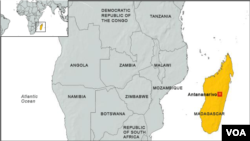The World Health Organization warned an outbreak of plague in Madagascar could spread rapidly throughout the country.
Madagascar's health ministry reported Tuesday that the disease has killed 47 people and said the number of suspected cases is up to 138.
Reports of an outbreak of plague in Madagascar conjure up chilling images of the Black Death, which killed 25 million people in Medieval Europe. The country is far from this apocalyptic scenario.
But, the WHO said it is concerned that this fatal disease could infect many people and it is working with authorities and partner agencies in Madagascar to contain the outbreak.
A recurring problem
The plague is not new to Madagascar. It recurs annually.
However, WHO spokesman Christian Lindmeier said the U.N. health agency is particularly concerned about this outbreak because the number of cases of plague appears to be higher than in recent years.
“Cases have been reported in 16 districts of seven regions. In Antananarivo, the capital and largest city in Madagascar, also two recorded cases have been identified, including one death," Lindmeier said.
"There is now a risk of rapid spread of the disease due to the city’s high population density and the weakness of the health care system," he said. "The situation is further complicated by the high level of resistance to deltamethrin, which is an insecticide used to control fleas that has been observed in the country.”
The first case of the plague was identified on August 31. The patient died three days later. However, the authorities in Madagascar did not notify WHO of the outbreak until November 4.
Prevention measures implemented
Lindmeier said measures for the control and prevention of plague are being implemented in the affected districts. He said personal protective equipment, insecticides, spray materials and antibiotics are being made available in those areas.
He said a WHO expert has gone to Madagascar to work with the authorities, to fully investigate the situation and to see what more needs to be done to bring the disease under control.
“Plague can be a very severe disease in people with a case fatality ratio of 30 to 60 percent if left untreated," Lindmeier said.
The plague is caused by the bacteria Yersinia pestis, a zoonotic bacteria usually found in small animals and their fleas, he said, adding people infected with plague usually develop flu-like symptoms after an incubation period of three to seven days.
Humans bitten by an infected flea usually develop a bubonic form of plague, which causes the swelling of the lymph node.
If the bacteria reach the lungs, the patient develops pneumonia. This can be transmitted from person to person through infected droplets spread by coughing.
Bubonic plague can be successfully treated with antibiotics if caught early. On the other hand, the WHO said pneumonic plague is one of the most deadly infectious diseases. It can kill patients within 24 hours after infection.
So far, the WHO said only 2 percent of reported cases are of the pneumonic form.









